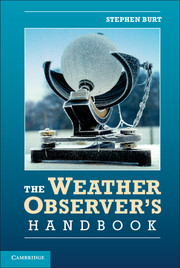Book contents
- Frontmatter
- Contents
- Acknowledgements
- Abbreviations, footnotes and references
- Part One The basics
- Part Two Measuring the weather
- 5 Measuring the temperature of the air
- 6 Measuring precipitation
- 7 Measuring atmospheric pressure
- 8 Measuring humidity
- 9 Measuring wind speed and direction
- 10 Measuring grass and earth temperatures
- 11 Measuring sunshine and solar radiation
- 12 Observing hours and time standards
- 13 Dataloggers and AWS software
- 14 Non-instrumental weather observing
- 15 Calibration
- 16 Metadata – what is it, and why is it important?
- Part Three Making the most of your observations
- Appendix 1 Metrology and meteorology: The basics of instrument theory
- Appendix 2 Useful functions
- Appendix 3 Unit conversions
- Appendix 4 Useful sources
- Index
- References
- Frontmatter
- Contents
- Acknowledgements
- Abbreviations, footnotes and references
- Part One The basics
- Part Two Measuring the weather
- 5 Measuring the temperature of the air
- 6 Measuring precipitation
- 7 Measuring atmospheric pressure
- 8 Measuring humidity
- 9 Measuring wind speed and direction
- 10 Measuring grass and earth temperatures
- 11 Measuring sunshine and solar radiation
- 12 Observing hours and time standards
- 13 Dataloggers and AWS software
- 14 Non-instrumental weather observing
- 15 Calibration
- 16 Metadata – what is it, and why is it important?
- Part Three Making the most of your observations
- Appendix 1 Metrology and meteorology: The basics of instrument theory
- Appendix 2 Useful functions
- Appendix 3 Unit conversions
- Appendix 4 Useful sources
- Index
- References
Summary
“The person who has only one watch knows what time it is, but the person who has two is . . . not sure.”
A favourite saying of professional metrologists, quoted by Richard Davis, formerly head of the Bureau International des Poids et Mesures (BIPM) mass division, at the Royal Society in London, 24 January 2011
Instrument calibrations are both one of the most important, and yet also one of the most neglected, areas of weather measurement. We have already seen in Chapter 2 that precision is not the same as accuracy. To make accurate weather measurements the instruments themselves need to be accurately calibrated, or at least regularly compared against instruments of known calibration to quantify any differences, or error (which should then be added to, or subtracted from, the observed reading to give the true value). As calibrations can drift over time, the calibration should be checked regularly, and adjusted if necessary. An error of 1 degree Celsius in temperature, or 20 per cent in rainfall, may not seem very significant on a day-to-day basis, but if monthly or annual values are adrift by even half this amount, the readings obtained will not be comparable with other locations, or with historical records. A 1 degree Celsius difference in mean air temperature corresponds on average to about 150 metres difference in altitude, or to the difference in annual mean temperature between London and Paris, or between Boston and New York.
One difficulty that applies to calibrating weather instruments is that, without a duplicate set of instruments, removing the sensor (and sometimes the logger too) for offsite calibration means that the record from that instrument is lost while it is away, which may be for several weeks. Therefore, methods which allow in situ calibration of the instruments are preferable. Depending on the instrument type, this can be achieved using an ‘absolute’ or ‘fixed point’ method, or by comparing readings over a period with a portable reference instrument whose calibration is accurately known.
- Type
- Chapter
- Information
- The Weather Observer's Handbook , pp. 304 - 321Publisher: Cambridge University PressPrint publication year: 2012



